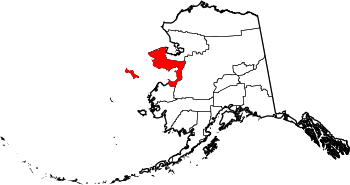Stebbins, Alaska
| Stebbins Tapraq | |
|---|---|
| City | |
 Stebbins Location in Alaska | |
| Coordinates: 63°30′43″N 162°16′29″W / 63.51194°N 162.27472°WCoordinates: 63°30′43″N 162°16′29″W / 63.51194°N 162.27472°W | |
| Country | United States |
| State | Alaska |
| Census Area | Nome |
| Incorporated | July 15, 1969[1] |
| Government | |
| • Mayor | Morris Nashanak, Sr.[2] |
| • State senator | Donald Olson (D) |
| • State rep. | Neal Foster (D) |
| Area | |
| • Total | 36.9 sq mi (95.6 km2) |
| • Land | 35.2 sq mi (91.1 km2) |
| • Water | 1.7 sq mi (4.5 km2) |
| Elevation | 16 ft (5 m) |
| Population (2010) | |
| • Total | 556 |
| • Density | 15/sq mi (5.8/km2) |
| Time zone | Alaska (AKST) (UTC-9) |
| • Summer (DST) | AKDT (UTC-8) |
| ZIP code | 99671 |
| Area code | 907 |
| FIPS code | 02-72960 |
Stebbins (Tapraq in Central Alaskan Yup'ik, Tapqaq in Iñupiaq) is a city in Nome Census Area, Alaska, United States. At the 2010 census the population was 556.
Geography
Stebbins is located at 63°30′43″N 162°16′29″W / 63.51194°N 162.27472°W (63.511893, -162.274632),[3] on the north side of St. Michael Island, which is on the south side of the Norton Sound in western Alaska.
According to the United States Census Bureau, the city has a total area of 36.9 square miles (96 km2), of which, 35.2 square miles (91 km2) of it is land and 1.7 square miles (4.4 km2) of it (4.71%) is water.
Demographics
| Historical population | |||
|---|---|---|---|
| Census | Pop. | %± | |
| 1940 | 98 | — | |
| 1950 | 115 | 17.3% | |
| 1960 | 158 | 37.4% | |
| 1970 | 231 | 46.2% | |
| 1980 | 331 | 43.3% | |
| 1990 | 400 | 20.8% | |
| 2000 | 547 | 36.8% | |
| 2010 | 556 | 1.6% | |
| Est. 2015 | 572 | [4] | 2.9% |
As of the census[6] of 2000, there were 547 people, 123 households, and 104 families residing in the city. The population density was 15.6 people per square mile (6.0/km²). There were 134 housing units at an average density of 3.8 per square mile (1.5/km²). The racial makeup of the city was 5.12% White, 0.18% Black or African American, 93.97% Native American, and 0.73% from two or more races.
There were 123 households out of which 64.2% had children under the age of 18 living with them, 47.2% were married couples living together, 11.4% had a female householder with no husband present, and 15.4% were non-families. 12.2% of all households were made up of individuals and 0.8% had someone living alone who was 65 years of age or older. The average household size was 4.45 and the average family size was 4.86.
In the city the age distribution of the population shows 47.2% under the age of 18, 12.4% from 18 to 24, 22.1% from 25 to 44, 13.7% from 45 to 64, and 4.6% who were 65 years of age or older. The median age was 20 years. For every 100 females there were 115.4 males. For every 100 females age 18 and over, there were 114.1 males.
The median income for a household in the city was $23,125, and the median income for a family was $28,214. Males had a median income of $33,125 versus $20,000 for females. The per capita income for the city was $8,249. About 40.4% of families and 41.9% of the population were below the poverty line, including 45.5% of those under age 18 and 33.3% of those age 65 or over.
Education
Stebbins is served by the Bering Strait School District. Tukurngailnguq School is the only school in town and serves grades K through 12.
History
A Russian fort, Redoubt St. Michael, was built at nearby St. Michael by the Russian-American Company in 1833. The name Stebbins was first recorded in 1900; the Yupik name for the village is Tapraq. The first census in the area, in 1950, listed 80 Yupiks residing in Stebbins. The city was incorporated in 1969.
The Stebbins economy depends on commercial fishing, for herring and other fish, and subsistence fishing, gardening and hunting, supplemented by part-time wage earnings. Hunting is for seal, walrus, caribou, and beluga whale. The city government and school of about 200 students provide the only full-time positions.
The Stebbins/St. Michael Reindeer Corral Project was completed in 1993 for a herd on Stuart Island, just north of Stebbins. The reindeer are currently unmanaged.
References
- ↑ "Directory of Borough and City Officials 1974". Alaska Local Government. Juneau: Alaska Department of Community and Regional Affairs. XIII (2): 78. January 1974.
- ↑ 2015 Alaska Municipal Officials Directory. Juneau: Alaska Municipal League. 2015. p. 150.
- ↑ "US Gazetteer files: 2010, 2000, and 1990". United States Census Bureau. 2011-02-12. Retrieved 2011-04-23.
- ↑ "Annual Estimates of the Resident Population for Incorporated Places: April 1, 2010 to July 1, 2015". Retrieved July 2, 2016.
- ↑ "Census of Population and Housing". Census.gov. Retrieved June 4, 2015.
- ↑ "American FactFinder". United States Census Bureau. Retrieved 2008-01-31.
